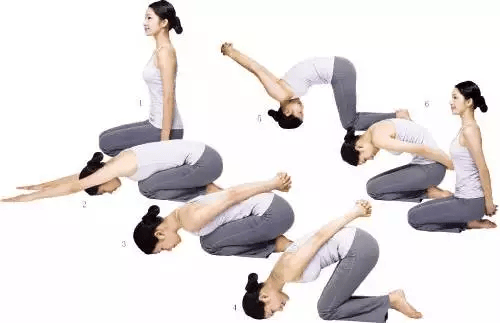Traditional Chinese medicine believes:
Ma: Indicates that Qi can come through, but blood cannot come through.
Mu: When Ma becomes severe, it is a blockage where both the blood and Qi cannot come through.
Sour: Indicates that the meridians are open, but there is insufficient Qi and blood.
Swelling: Indicates abundant Qi, these individuals have a hot-tempered constitution, if the Qi in the body cannot be released, swelling may occur.
Pain: Simple pain is due to blood stasis.
Itchy: Indicates that Qi and blood are flowing, wounds often itch during healing. However, this is different from generalized itching.
Kneeling is an excellent method to guide blood downward.
If Qi and blood cannot be directed to the soles of the feet all at once, start by guiding it to the knees. With ample Qi and blood at the knees, the distance to the feet is not far off.
On a slightly firm bed or carpet, walk on your knees; Qi and blood will flow continuously towards the knees. This replenishment of fresh blood to the knees helps disperse cold, eliminate swelling, and alleviate pain.
For those with knee pain, kneel on a softer surface without moving initially, gradually introduce gentle movements, and soon the knees will not ache.
The miraculous effects of kneeling
Why do knees ache? What causes knee wear and tear? How does fluid accumulation and swelling occur? These issues arise without any apparent cause. The knee is a joint, and if we frequently perform squatting movements, it leads to wear and tear just like a bearing.
As one ages, there is a decrease in Qi and blood supply to the knees. Since the knees experience constant wear and tear, the lubrication of Qi and blood becomes crucial. Sufficient lubrication prevents issues, while its deficiency leads to dry friction and wear, resulting in problems.
If cold Qi invades while there is poor blood circulation and one engages in activities such as squatting, climbing, or long walks, the knees wear down further. This is a primary reason why many middle-aged and elderly individuals experience worsening knee pain after exercise.
Exercise has benefits, but the context of the exercise matters. Exercising when the knees are already worn down exacerbates the situation. Although pressing the Yangguan acupoint can alleviate pain temporarily, the fundamental approach is to prevent wear and tear from the beginning.
The best way to promote blood flow is through the kneeling method—walking while kneeling. You will notice Qi and blood effortlessly flow to the knees, and as you walk while kneeling, you will feel movements in the waist, aiding kidney function.
After two to three weeks of walking while kneeling, you may notice a reduction in hair loss.
In traditional Chinese medicine, the knees are considered the residence of tendons, and the liver governs tendons. Therefore, the kneeling method is a significant liver-nourishing technique, akin to consuming Chinese herbal medicine daily without any cost, providing excellent effects regardless of constitution.
Some may say, “I cannot kneel due to bone spurs seen in my X-rays. Kneeling will surely worsen the condition, leading to punctures.” This is a misconception about bone spurs, which are a natural occurrence in the body as one ages.
Bone spurs themselves do not cause pain; pain arises due to pressure from the adjacent blood stasis on nerves. By dispersing the blood stasis, knee pain naturally diminishes. Imaging may still show bone spurs intact, as treatments claiming to dissolve spurs essentially manage the surrounding blood stasis. Therefore, the presence of bone spurs doesn’t hinder exercise. Kneeling practice has no adverse effects on the body.
Besides aiding in weight loss and preventing/treating knee pain, swelling, bone spurs, backache, and hair loss, kneeling practice offers numerous additional benefits.
For men and young women looking to lose weight, kneeling is a secret weight loss technique faster than “knocking the belt vessel.” The reduction of thigh fat is most noticeable. Measure your thighs before starting, kneel for 20 minutes daily, remeasure after three weeks, and witness significant slimming results.
Women often complain about excess fat on the thighs, which is non-muscle tissue. Drawing fresh Qi and blood to the area helps absorb waste and eliminate it, aiding in thigh slimming. Note that initial kneeling may cause knee pain, requiring some adaptation – start with kneeling before walking.
After kneeling practice, try standing on one leg (Golden Rooster Stands on One Leg) – you may notice improved balance. Kneeling practice directs substantial Qi and blood to the lower limbs, strengthening them for increased stability. This method opens the primary acupoints of the six meridians (Liver, Gallbladder, Spleen, Stomach, Kidney, Bladder) on the feet, ensuring sustained and robust Qi and blood circulation.
Some who practice kneeling, even for 10 minutes instead of the recommended 20 minutes daily, notice a 50-degree decrease in their glasses prescription. Despite being in their thirties, why such significant improvement? Kneeling nourishes the liver, which correlates to tendons. Since the knees are the focal point for tendons and the liver connects to the eyes, there is a noticeable improvement.
While kneeling and walking, tapping the Left Pericardium Meridian simultaneously enhances the effects. For those with hypertension, massaging the Luozhen Acupoint of the Lung Meridian offers immediate clarity in the mind. To effectively prevent diseases, understanding the interconnections between practices is essential – kneeling isn’t just for knee issues or specific acupoints but extends to holistic health.
As the saying goes, “Drinking half a cup of lake water, you understand the essence of rivers; picking up a fallen leaf, you enjoy the autumn breeze on Earth,” emphasizing the approach of broadening perspectives in learning. Connecting various ideas accelerates learning. By associating the knee’s network and functions with others, you deepen the understanding of the body.
These methods are simple, catering to a wide range of conditions. They can be tried by those experiencing bloating, headaches, cold feet, insomnia, agitation, or instability. With time, one may find tranquility and mental clarity.


